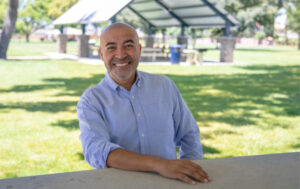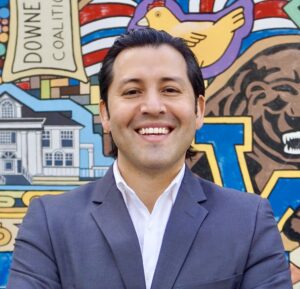Layla Hernandez
Incumbent Gabi Gomez is running for re-election on the Bell Gardens City Council.
Nov. 5 is the last day to vote, with early voting available. To check registration status, request a vote-by-mail ballot, or find a local voting center, visit lavote.gov.
Gomez was appointed to council last year to replace Councilmember Alejandra Cortez.
Gomez cites the needs of working families, public safety, and economic development as top priorities, stating, “I’m committed to fostering partnerships at the local, state, and federal levels to bring much needed resources to our community.”
On top of the city’s rent stabilization ordinance, Gomez believes in enforcing the rental registry, additional support and resources for eviction prevention, and rental subsidy programs, saying such programs “ensures that our city remains inclusive and supportive of all its residents.”
Gomez believes the police budget should remain the same, though also proposes the idea of expanding community-based engagement, stating “community engagement plays a critical role in preventing crime and building trust.”
Gomez has lived in Bell Gardens for more than 10 years.
Responses have been lightly edited for clarity. Candidate self-reported their occupation and residence.
Why are you running?
I am running for Bell Gardens City Council because our community deserves strong, compassionate leadership that prioritizes the needs of working families, promotes public safety, and drives economic development. As a resident and public servant with over 30 years of experience in social services, I’ve seen firsthand the challenges our city faces—from the need for housing justice for our most vulnerable residents, to improved mobility options, to ensuring everyone has access to essential services. I’m committed to fostering partnerships at the local, state, and federal levels to bring much needed resources to our community.
I want to build on the work I’ve already started in council, such as advocating for safe streets, supporting our police department, and promoting revenue diversification to help our city thrive. I also want to continue championing environmental and mobility justice, ensuring that our infrastructure supports cycling and other transportation alternatives to cars for residents who need them.
Bell Gardens is my home, and I want to continue working to make it a place where everyone feels safe, supported, and has the opportunity to succeed. That’s why I’m running for City Council—to ensure that we build a vibrant, inclusive future for all.
Bell Gardens passed rent stabilization in 2022, establishing a framework to limit excessive rent increases. However, rents are still rising. What are some other solutions that can help prevent renters from being priced out of the city due to these rising costs?
One of the most critical challenges facing renters in Bell Gardens and throughout Los Angeles County is the rising cost of housing, which threatens to displace families, especially those with children and seniors. According to the Los Angeles Homeless Services Authority (LAHSA), in 2023, 8,300 families with children were unhoused, while seniors (aged 62 and over) made up 22% of the homeless population. These numbers are deeply troubling and highlight the urgent need to stabilize housing for our most vulnerable residents.
In Bell Gardens, where nearly 80% of residents are renters, the majority of households are living on low to moderate incomes. The median household income in the city is about $50,000, far below the county average, which makes rising rents a significant burden for many. In addition to protecting our Rent Stabilization Ordinance and enforcing the Rental Registry, providing additional support and resources for eviction prevention and rental subsidy programs will help to ensure that families and seniors remain safe and housed. Preventing displacement not only keeps families together but also ensures that our city remains inclusive and supportive of all its residents.
The police department makes up 42.3% of the city budget. Do you think this is the right amount of spending? What public safety strategies do you think the city could implement that don’t rely on traditional policing?
The city’s budget allocation to the Bell Gardens Police Department (BGPD) reflects our ongoing commitment to public safety. While maintaining a strong police presence is necessary to keep our community safe, I believe we should also invest in alternative public safety strategies that don’t rely entirely on law enforcement. That’s why, in addition to the police department’s budget, we are continuously looking for ways to supplement these funds through innovative grants and partnerships that help us expand our community-based engagement opportunities with educational events at schools and community venues.
Community engagement plays a critical role in preventing crime and building trust. Programs like Neighborhood Watch, which actively involve residents in monitoring their neighborhoods, are great examples of collaborative efforts that reduce crime while empowering the community. I believe we can explore more non-traditional public safety strategies that focus on prevention and intervention. By expanding mental health crisis intervention teams to respond to non-violent situations more effectively than police officers, and increasing investment in youth programs, job training, and after-school initiatives we can help prevent crime before it starts.
While our police department’s budget is important for our city’s safety, supplementing it with grants and investing in alternative public safety strategies allows us to create a more holistic approach to protecting our community. Balancing traditional law enforcement with innovative, community-based solutions, will ensure that Bell Gardens remains a safe and thriving city.
Should the police budget increase, decrease, or stay the same?
Stay the same.
The 2020 Complete Streets Plan identifies the necessity of improved pedestrian and cycling infrastructure in anticipation of the Southeast Gateway Line, expected to operate by 2035. If elected, what would you prioritize from the 202 Complete Streets Plan? How would you address any community concerns regarding increased car traffic during its implementation?
When I am elected, my top priority from the 2020 Complete Streets Plan would be to improve pedestrian and cycling infrastructure to ensure that residents have safe, reliable access across the Los Angeles River and the I-710 to the future Southeast Gateway Line stations planned in South Gate, Cudahy, and Bell. As we prepare for the completion of this new transit line by 2035, we need to start developing the necessary infrastructure that promotes cycling, walking, and other forms of micro mobility, reducing our reliance on cars, enhancing mobility, improving public health, and mitigating traffic congestion.
Safe and accessible routes to transit hubs are essential to making public transportation a viable option for our community. In line with the Complete Streets Plan, the repainting of sharrows and bike lanes with high-visibility materials, which I advocated for, has been completed, along with the addition of dedicated pedestrian pathways and enhanced lighting to make these routes safer for everyone.
Community concerns about increased car traffic during the implementation phase are understandable, but we can address these by taking proactive measures. For instance, I would work with traffic engineers to ensure that construction is staggered in a way that minimizes disruptions to daily commutes. Temporary traffic calming measures, like additional signage and rerouting plans, can help mitigate the impact on car traffic while construction is underway.
We also need to focus on the long-term benefits of these infrastructure improvements. By making it easier for people to walk, scoot, skate, or bike to the Southeast Gateway Line, we can reduce car usage over time. This will help alleviate traffic congestion in the future, rather than add to it.
Maintaining an open dialogue with the community throughout the implementation process is essential. Hosting regular community meetings and providing updates on construction timelines and traffic mitigation efforts will help address concerns and keep residents informed. By prioritizing safe and accessible pedestrian and cycling routes, we can ensure the Southeast Gateway Line is a success for everyone, making Bell Gardens a more connected, sustainable city.







